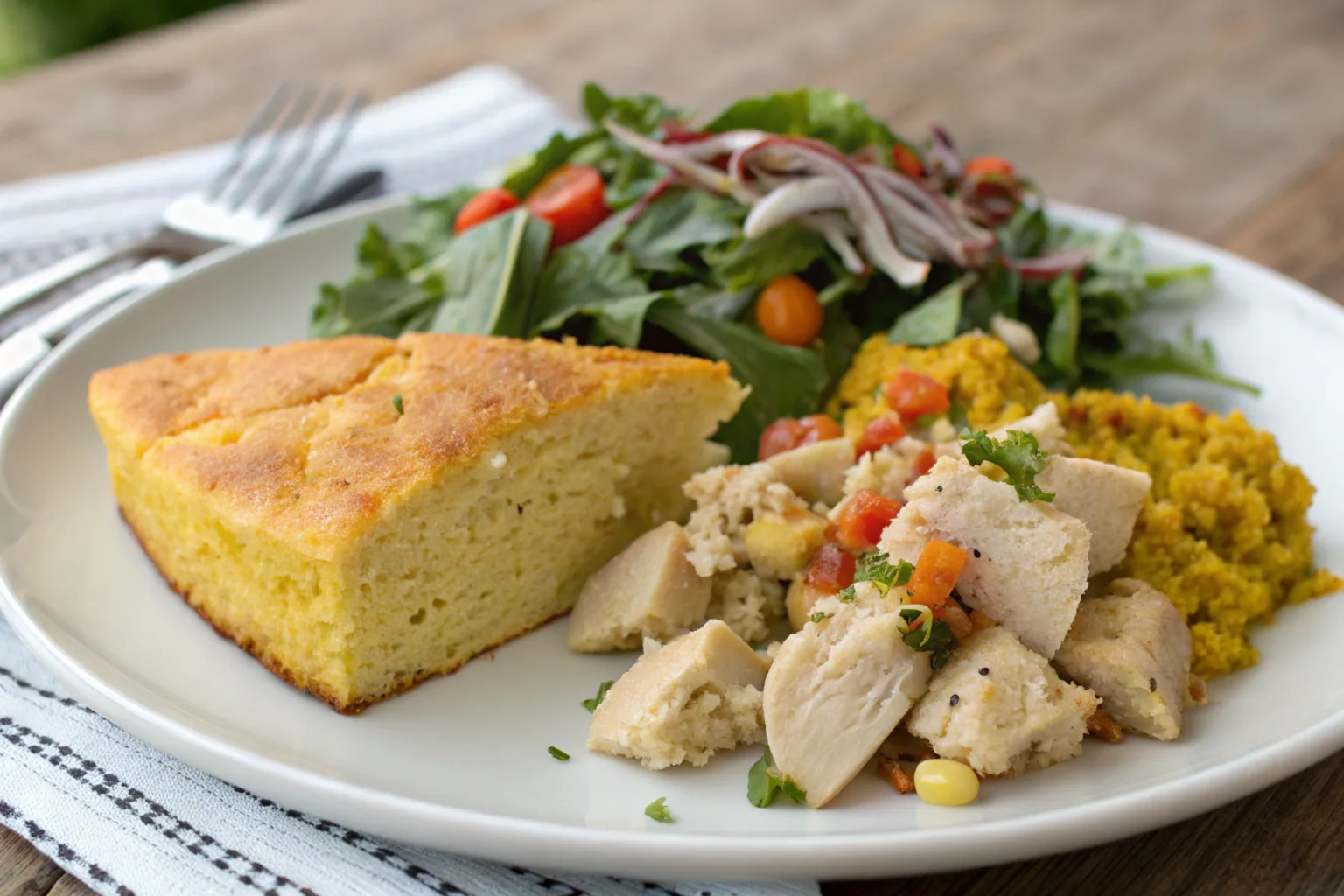Introduction
Have you ever baked a batch of cornbread only to find it’s more gritty than smooth? You’re not alone. Gritty cornbread can be a frustrating kitchen mishap, but the good news is, it’s easily fixable. Whether it’s the type of cornmeal you’re using, your mixing technique, or even your cooking method, there are plenty of factors that can affect your cornbread’s texture.
In this guide, we’ll uncover the common reasons behind gritty cornbread and how to avoid them. From choosing the right cornmeal to perfecting your batter, you’ll learn the secrets to smooth, delicious cornbread every time. Plus, we’ll highlight some delicious ways to use cornbread, like in this Cornbread Dressing with Chicken for a hearty family favorite.
What Makes Cornbread Gritty?
Cornbread’s texture can range from delightfully crumbly to frustratingly gritty, and understanding the factors that influence its consistency is key to perfecting your recipe.
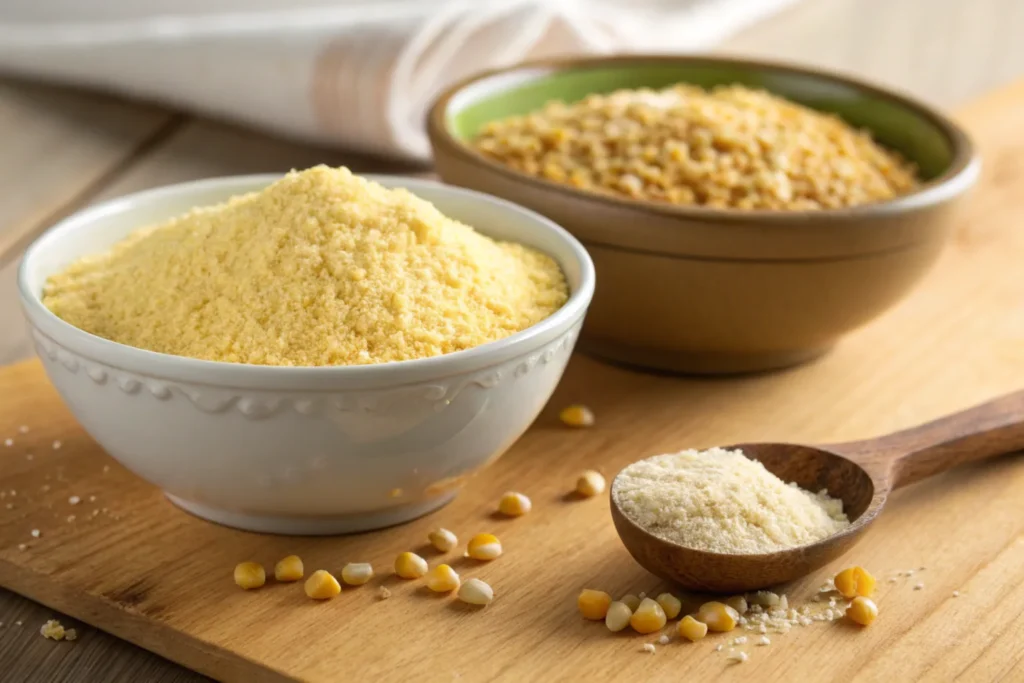
Understanding Cornmeal Texture
The texture of your cornmeal plays a significant role in how your cornbread turns out. Coarsely ground cornmeal can result in a gritty texture, as the larger grains don’t break down completely during baking. Finely ground cornmeal, on the other hand, yields a smoother, more uniform crumb. When in doubt, opt for medium or finely ground cornmeal for the best results.
For insights into how regional preferences affect cornbread, check out this comparison of Southern Cornbread vs. New York Cornbread—you might discover the style that suits your taste!
The Role of Ingredients in Texture
Every ingredient in your cornbread recipe contributes to its final texture. Using water instead of milk, for instance, can make the batter thinner and less able to bind the cornmeal together, leading to grittiness. Similarly, the absence of eggs or other binders, like in this Cornbread Stuffing Without Eggs, requires adjustments to achieve the right consistency.
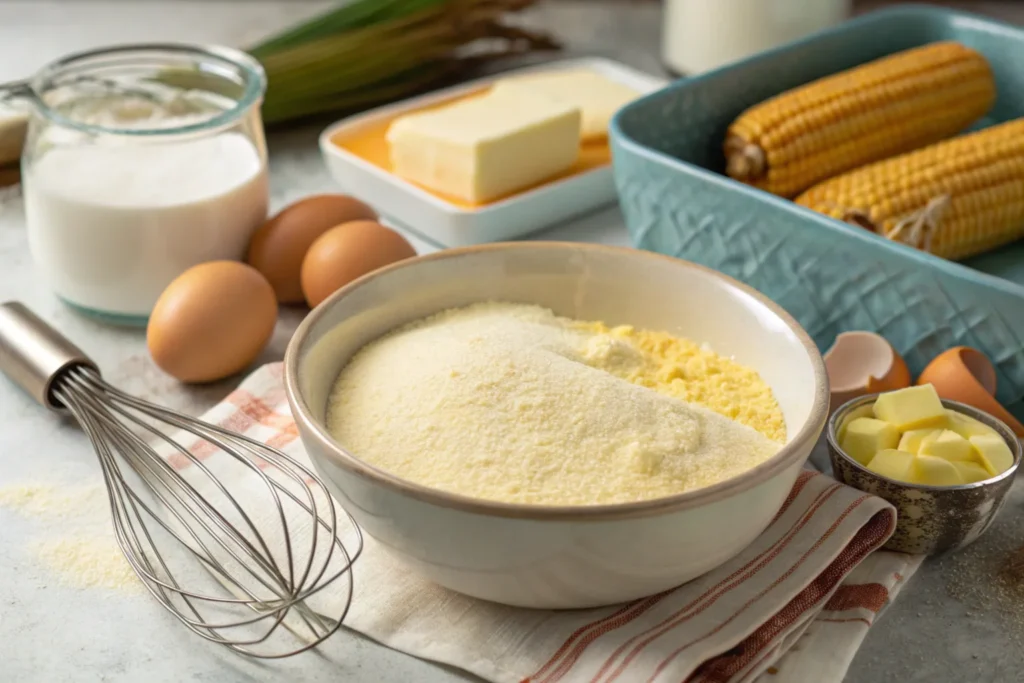
How Cooking Methods Affect Grittiness
Cooking techniques also matter. If your batter isn’t allowed to rest before baking, the cornmeal might not have enough time to absorb the liquids, leaving it partially uncooked and gritty. Additionally, baking at too low a temperature can prolong cooking time, preventing the cornbread from developing a uniform texture.
Common Mistakes That Lead to Gritty Cornbread
Making cornbread seems simple, but a few common pitfalls can leave you with a gritty texture instead of the smooth, tender crumb you’re aiming for. Let’s break down these mistakes and how to avoid them.
Using the Wrong Type of Cornmeal
Choosing coarsely ground cornmeal when the recipe calls for medium or fine can result in a gritty texture. Always check the recipe’s requirements, and when in doubt, go for a finer grind. If you’re exploring traditional Southern recipes, this Southern Cornbread Recipe (Beef Tallow) offers tips on choosing the right cornmeal for authentic flavor and texture.
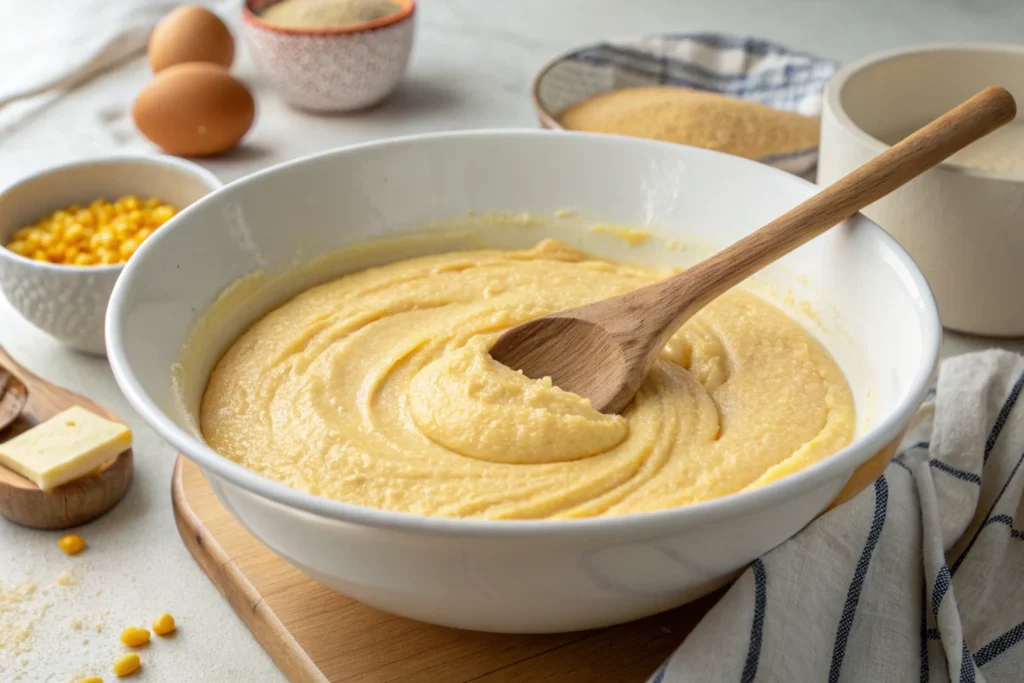
Skipping the Soaking Step
Cornmeal benefits from soaking in liquid before baking. This step softens the grains, helping them absorb moisture and break down during cooking. Skipping this step can leave your cornbread with a grainy bite.
Overmixing or Undermixing the Batter
Overmixing the batter activates gluten in the flour, making the cornbread tough and unevenly textured. On the flip side, undermixing can leave pockets of dry cornmeal, leading to an inconsistent texture. Aim for a smooth batter with no visible dry spots.
Baking at Incorrect Temperatures
Baking cornbread at too low a temperature can prevent the batter from cooking evenly, leaving you with a gritty texture. Always preheat your oven to the recommended temperature, typically 375°F to 400°F.
Mistakes happen, but understanding these pitfalls can help you perfect your recipe.
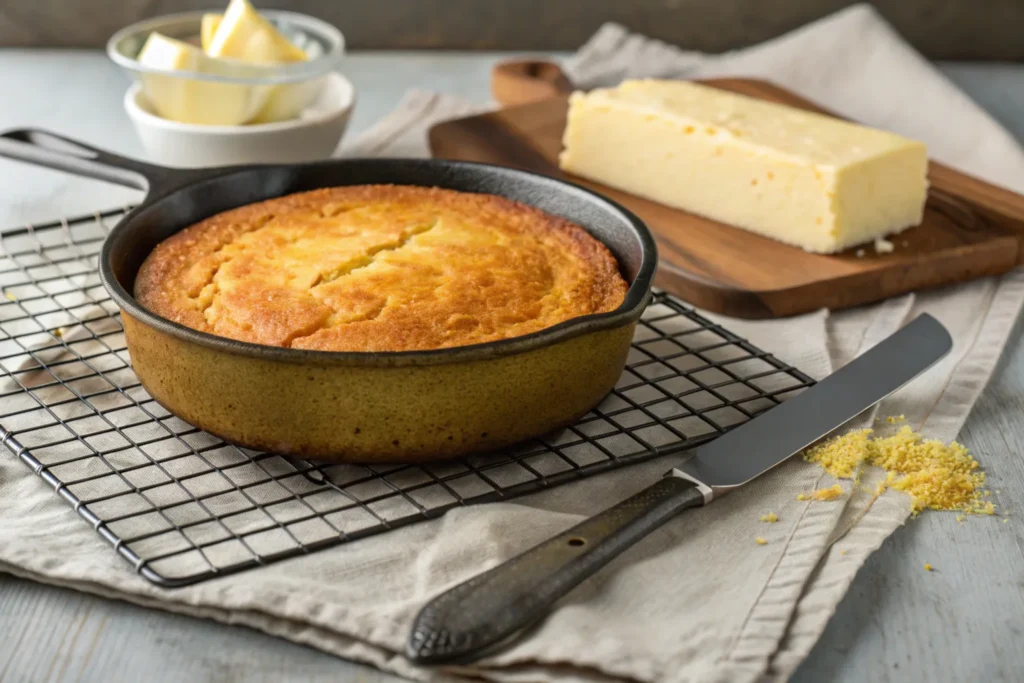
How to Fix Gritty Cornbread
If you’ve been struggling with gritty cornbread, don’t worry—there are simple fixes to ensure your cornbread comes out smooth and delicious every time.
Choosing the Right Cornmeal
The first step to avoiding gritty cornbread is selecting the appropriate cornmeal. Opt for medium or finely ground cornmeal, which cooks more evenly and absorbs liquids better. For authentic Southern-style cornbread, consider trying this Southern Cornbread Recipe (Beef Tallow) for guidance on achieving perfect texture.
Tips for Soaking Cornmeal
Soaking your cornmeal is a game-changer. Mix the cornmeal with your liquid ingredients (milk, buttermilk, or water) and let it sit for 15–30 minutes before combining with the rest of the batter. This allows the grains to soften, resulting in a smoother crumb.
Adjusting Your Batter for a Smoother Texture
Balance is key. If your batter feels too thick, add a splash of liquid to loosen it up. If it’s too thin, incorporate a tablespoon of flour to help bind the mixture. This is particularly important when adapting recipes, like this Vegan Cornbread Dressing Recipe, where different ingredients can affect consistency.
Baking Tips for Consistency
Preheat your oven to the correct temperature and bake the cornbread in the middle rack to ensure even heat distribution. Also, avoid opening the oven door frequently, as this can disrupt the cooking process and lead to uneven texture.
With these fixes, you’ll achieve cornbread that’s smooth, tender, and ready to shine.
Variations to Improve Cornbread Texture
If you’re looking to elevate your cornbread and avoid grittiness, experimenting with recipe variations can make a big difference. From adding rich ingredients to balancing the cornmeal’s texture, here are some ideas to try.
Adding Buttermilk for Moisture
Buttermilk not only enhances flavor but also tenderizes the cornmeal, creating a smoother crumb. Its slight acidity helps break down the grains, making it an excellent substitution for regular milk. Pair this with recipes like Cornbread Dressing with Chicken to bring out the dish’s full potential.
Mixing Cornmeal with Flour for a Balanced Texture
Combining cornmeal with all-purpose flour is a tried-and-true method for softening cornbread. The flour adds structure and lightness, reducing the gritty feel of pure cornmeal. Adjust the ratio to your preference—try a 2:1 ratio of cornmeal to flour for a perfect balance.
Incorporating Sweeteners or Fats
Adding a small amount of sugar or honey can subtly enhance the cornbread’s flavor while improving its texture. Similarly, incorporating fats like melted butter, vegetable oil, or beef tallow (as seen in this Southern Cornbread Recipe) can make the crumb softer and more cohesive.
Experimenting with Diet-Friendly Adaptations
Adapting cornbread recipes for dietary needs, like in this Cornbread Stuffing Without Eggs or Vegan Cornbread Dressing, can also improve texture. These recipes often rely on creative substitutes that can yield surprising improvements in smoothness.
FAQs About Cornbread Texture
Cornbread can turn out grainy if you use coarse cornmeal or skip key steps like soaking the cornmeal before baking. Coarse grains don’t fully soften during cooking, leading to a gritty texture. The type of liquid and mixing technique can also affect the final crumb.
Soaking the cornmeal in liquid (milk, buttermilk, or water) for 15–30 minutes before mixing the batter helps soften the grains and reduce grittiness. You can also use finely ground cornmeal or mix it with all-purpose flour for a smoother texture.
Cornmeal’s grittiness comes from its coarse grind. Coarsely ground cornmeal is great for rustic textures but can feel gritty in baked goods like cornbread. Opt for medium or finely ground cornmeal for a softer crumb.
Overmixing cornbread batter activates the gluten in the flour, which can lead to a tough, dense texture. It can also incorporate too much air, causing the cornbread to rise unevenly and create pockets of grittiness. Mix just until the ingredients are combined.
Medium ground cornmeal is generally better for cornbread because it provides a balanced texture that’s not too gritty. Coarse cornmeal can work for more rustic recipes but may require soaking or blending with flour to avoid excessive grittiness.
Yes, letting cornbread batter rest for 10–15 minutes allows the cornmeal to absorb the liquid, softening the grains and creating a more cohesive texture. This simple step can significantly improve the final result.
Conclusion – Smoother Cornbread Every Time
Cornbread is a beloved classic, but achieving the perfect texture can be tricky. Gritty cornbread often comes down to choosing the wrong cornmeal, skipping crucial steps like soaking, or overmixing the batter. By selecting medium or finely ground cornmeal, soaking it before baking, and handling your batter with care, you can create cornbread that’s tender, smooth, and absolutely delicious.
Whether you’re sticking to traditional Southern recipes, experimenting with modern twists, or using it in dishes like Cornbread Dressing with Chicken or Rotisserie Chicken Casserole Stuffing, the right techniques make all the difference.
So the next time you whip up a batch of cornbread, keep these tips and tricks in mind. With a little practice and the right approach, you’ll be serving up perfectly smooth and flavorful cornbread that everyone will love.

